|
|
Other high-powered wind turbines were tried out at this time on an experimental basis. It is not our intention to be exhaustive about them.
Among the wind turbines contemporary to the one in Nogent-le-Roi, we can mention:
- The Smith-Putnam two-bladed asynchronous variable pitch wind generator built in 1945 by Morgan Smith and Company in Grandpa'Knob (Vermont, USA) with a rated power of 1,250 kW. The propeller had a diameter of 53 metres. It lost one of its blades during a test and was scrapped.
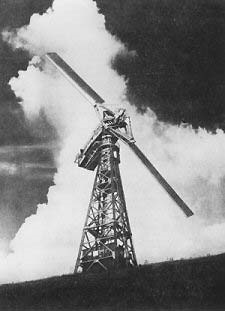 |
| The SmithPutnam wind turbine |
- The Neyrpic asynchronous wind turbines of 130 and 1,000 kW, which were operated by EDF at Saint-Rémy-des-Landes (Manche), at the same time as the one at Nogent-le-Roi. The 130 kW machine was scrapped in 1965 and the 1,000 kW machine was dismantled and taken over by Neyrpic, EDF having suspended research. The 1,000 kW wind turbine produced 500,000 kWh in 7 months of operation. Its record power was 1,085 kW. The propeller was hydraulically controlled variable pitch (see minutes). Read the article by Mr. Etienne Rogier published on the website of the Fédération des Moulins de France.
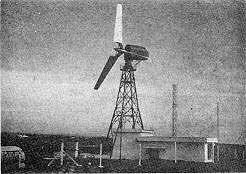 |
| 21 m Machine, 130 kW |
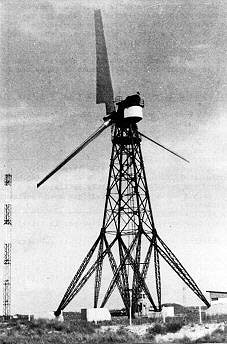 |
| 35 m Machine, kW 1 000 kW |
| Neyrpic wind turbines in Saint-Rémy-des-Landes. |
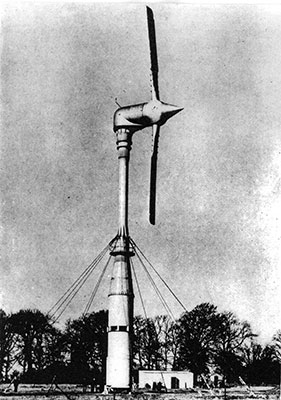 |
| Eolienne Andreau à Saint-Albans (Royaume Uni) |
- The aborted project of 1963. That year, Lucien Romani and the BEST presented to the EDF Research Department a project for a wind turbine that could be erected without the intervention of a monumental crane and then operate without permanent staff.
- It was the result of long preliminary studies, carried out with the help of the Laboratoire Central des Ponts et Chaussées, the LBTP, the O.N.E.R.A., Breguet, the CIMT, Sud-Aviation, the Entreprise Générale Industrielle, Neyrplast, Alsthom, the Société des Monteurs-Levageurs, etc...
- The plan was to have two counter-rotating 32-metre diameter wind turbines, close to each other and located in the same plane on a truncated cone-shaped tower made of a thin reinforced concrete shell. Each propeller would have driven, via a gearbox, a 1000 kW synchronous generator.
- Tests carried out at the Breguet wind tunnel in Vélizy proved that this arrangement provided a 10% gain compared to two similar propellers located far apart.
- Economic studies carried out by EDF's Direction de l'equipment showed that, on the basis of an average use of 2,150 hours/year, the cost of the energy produced would have been 30 to 50% higher than that of energy produced from oil. The project was abandoned.
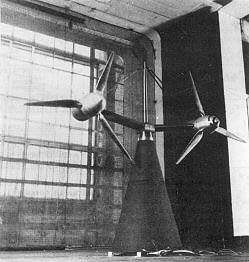 |
| Model of the BEST double propeller wind turbine |
- The Neyrpic project of 1984. A visitor tells me that "In 1984 a new project emerged. It was about the possible realization of a 25 m wind turbine with the CEA with the help of the French Agency for the Control of Energy and the EEC. But the situation was not very favourable because on the EDF side the judgement was still generally bad (therefore no intention on their part to finance in this field)" to which were added "difficulties on the AFME side. Neyrpic was unable to obtain all the aid required and, in 1985, had to admit that the project was in a "bad position" (I quote). Note: For the record, according to what I have read, this machine was probably installed in Corsica".
|




